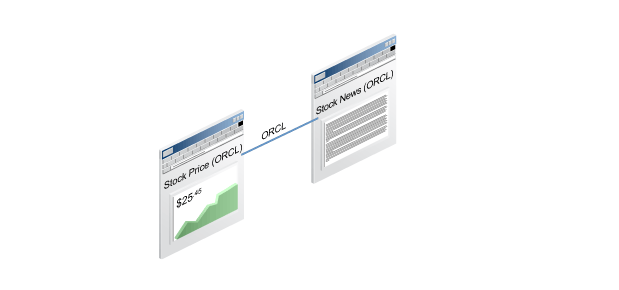
Mashup or Wire Components and Portlets Together
One
way to make sure that your users are exposed to information that is in context
is by wiring—or mashing up—related components or portlets together so that
their content is always synchronized. In Oracle WebCenter, this is called
the Contextual Event Framework. To provide a rich, dynamic application
or portal, Oracle WebCenter Framework enables you to wire together Oracle
ADF Faces componets, WSRP portlets, PDK-Java portlets, and task flows. For
example, suppose you have the Stock Price and Stock Headlines portlets on
the same page. These portlets—which are wired together—are based on the
stock ticker symbol. When the stock ticker symbol is changed in the Stock
Price portlet, the Stock Headlines portlet picks up that change and refreshes
with headlines for the same ticker symbol.
By wiring page variables to portlet parameters, you can enable the portlets on the page to adapt to their context. For example, consider a page that contains a customer identifier variable. If related portlets on the page use the customer identifier value to determine the information to display, a customer details portlet parameter wired to the page variable could parse the customer identifier value to determine the customer information to display.
Finally, the key is that the Contextual Event Framework provides the ability to refresh only the contents of affected components. This ensures a rich, dynamic, and intuitive user experience that does not rely on the user knowing when or how to refresh the page, and requires no direct coding to deliver rich Web 2.0 applications and portals.
By wiring page variables to portlet parameters, you can enable the portlets on the page to adapt to their context. For example, consider a page that contains a customer identifier variable. If related portlets on the page use the customer identifier value to determine the information to display, a customer details portlet parameter wired to the page variable could parse the customer identifier value to determine the customer information to display.
Finally, the key is that the Contextual Event Framework provides the ability to refresh only the contents of affected components. This ensures a rich, dynamic, and intuitive user experience that does not rely on the user knowing when or how to refresh the page, and requires no direct coding to deliver rich Web 2.0 applications and portals.